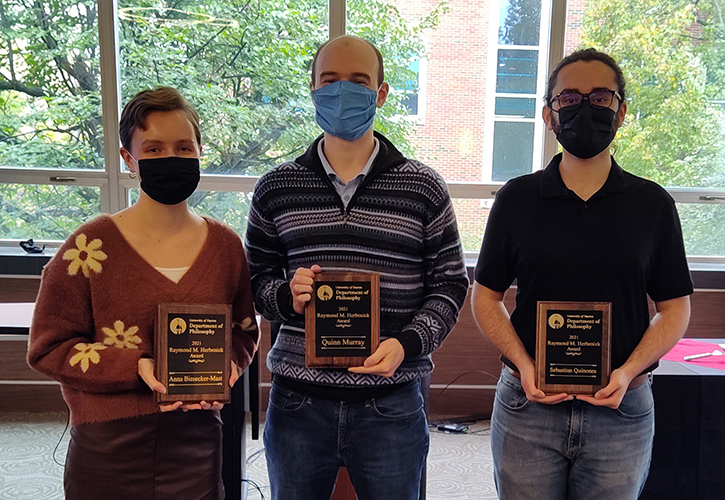College of Arts and Sciences Newsroom

University of Dayton Core program honors three students with Herbenick Award for excellence in interdisciplinary education
By Leslie Kuhnen
The University of Dayton Core program recognized three students with the Raymond M. Herbenick Award at its 34th annual graduation banquet in October, marking the first time in the program’s history that a trio of students won the award.
This year’s winners were Anna Biesecker-Mast, Sebastian Quinones and Quinn Murray. All three were nominated and selected by Core faculty members.
The Herbenick Award is presented annually and recognizes a Core graduating student who best exemplifies the program’s commitment to excellence in interdisciplinary integration. Created by the Department of Philosophy in 1999, it is named in honor of founding Core professor Ray Herbenick.
“I was thrilled to be part of a three-way tie for the 2021 Herbenick Award,” said Murray, a senior biochemistry major from Oakwood, Ohio. “The other two award winners are hardworking and intelligent; I’m flattered to be placed in the same category as them.”
Murray joined the Core program as a biology major because he was drawn to the program’s interdisciplinary curriculum, as well as the honors program credit it offers.
“Rare is a student who has Quinn’s level of confidence and that ability to step outside the lines of conventional research and thought to take advantage of a writing assignment as an opportunity to explore and grow, and not simply to satisfy what is required,” said Roger Crum professor of art history. ”That's what I so appreciated about Quinn and what stood behind my recommending him for the award.”
Biesecker-Mast, a senior English and history major from Oakwood, Ohio, was nominated by Elizabeth Mackay, associate professor of English.
“In my view, Anna was probably born to be a Herbenick Award winner, since she fully embodies and has embraced the humanities and interdisciplinary study with her declared double-major and a minor in women’s and gender studies,” Mackay said. “She is a quintessential Core student. In many ways, within and outside of the University, Anna has represented and demonstrated the integrated knowledge for which the Core program strives.”
Biesecker-Mast said she loved the interdisciplinary nature of Core from day one. She described the Core seminar as a unique space where a small group of students could discuss the complexities and interdisciplinary aspects of a lecture with a professor.
“In Core, I’ve taken classes in various humanities and social science disciplines together with the same group of 100 students for three years — it is a vibrant academic community,” Biesecker-Mast said.
Quinones, a senior English and history major from San Juan, Puerto Rico, initially knew little about Core, apart from it being an interdisciplinary living-learning program. He said it ended up being one of the best experiences of his life.
“I met interesting people and made new friendships with people I admire and care deeply about,” Quinones said. “From my professors, I learned to become a better writer and researcher — and the conversations were, at times, unforgettable. Overall, Core has helped mold me into the person I am today.”
Quinones was nominated by David Darrow, professor of history.
“Sebastian exemplifies Core in so many ways, from his enthusiastic embrace of interdisciplinary approaches to knowing, to his willingness to give back to the Core community as a writing fellow and spokesperson,” Darrow said. “In this and so many other ways, Sebastian personifies Core.”
The Core Program offers an innovative, interdisciplinary two-and-a-half year curriculum that stresses the connections between disciplines while fulfilling many of the University's Common Academic program requirements. Courses address a common theme, "Human Values in a Pluralistic Culture," and are carefully coordinated so students experience the integrated character of the arts and sciences. Co-curricular speakers, arts events and other activities related to course content are an important part of the program. The 120 students selected each year represent a cross-section of new students with differing backgrounds and abilities.
For more information, visit the Core program website.
Photo: Raymond M. Herbenick Award winners (L to R) Anna Biesecker-Mast, Quinn Murray and Sebastian Quinones.
